Worldcon Wayback Machine Introduction: Thirty years ago today ConFrancisco, the 1993 World Science Fiction Convention, began in San Francisco, California. I thought it would be fun to compile a day-by-day recreation drawing on the report I ran in File 770, Evelyn Leeper’s con report on Fanac.org (used with permission), and the contributions of others. Here is the first daily installment.
The Worldcon was held in the Moscone Convention Center, ANA Hotel, Parc Fifty Five, and Nikko Hotel.

[Mike Glyer] Booing Pavarotti: Sports fans can name the cities where crowds are always tough, knowledgeable and critical, prone to boo any mistake; so can opera buffs and bullfight aficionados. The Worldcon is similar, except that the tough crowd will go anywhere the con is held.
The comparison comes to mind because I heard unwarranted grumbling and sniping about ConFrancisco, criticism quite out of proportion to what I felt was the actual quality of the convention. This was a good, competently-run Worldcon which nevertheless had areas that could have worked a lot better by adopting the crowd-handling tactics of MagiCon (1992). Unfortunately, one of them was registration, and that made a poor first impression on many fans. Once fans were past the opening hurdles they discovered that ConFrancisco contained all the richness and variety expected of a Worldcon.
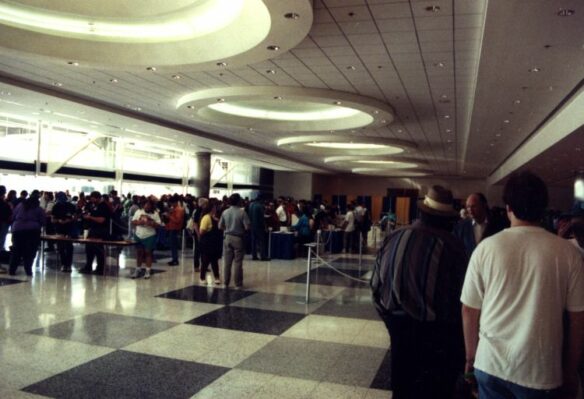
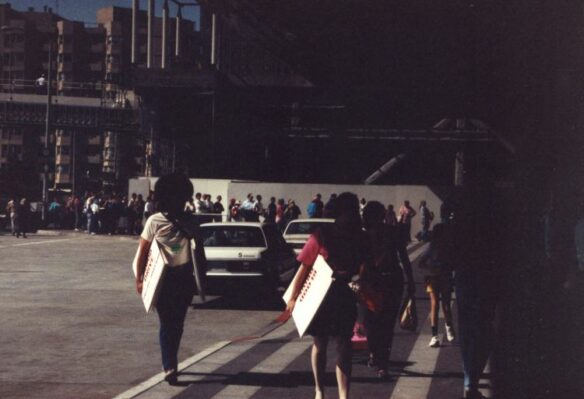
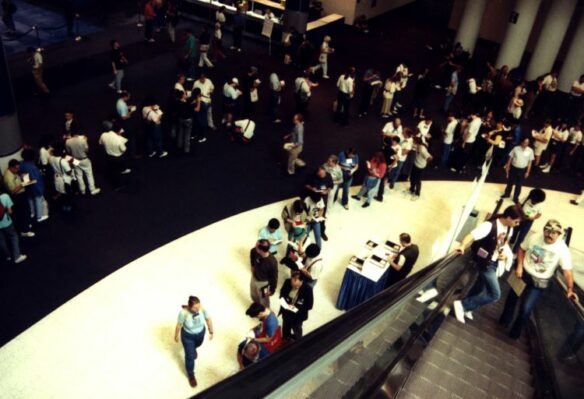
[Mike Glyer] The Longest One-Liner Town: On a clear, blue San Francisco day I pressed through the crowds lined up at the Powell Street cable car turntable and headed for the Moscone Convention Center, smugly grateful not to be in line for some tourist trap.
I crossed Market Street and in the next block saw a hole the size of an asteroid crater, full of scaffolding and concrete forms. The Moscone expansion proceeded on all sides, fortunately involving none of the interior space assigned to ConFrancisco. Taller than the catwalks, two ranks of international flags marked the entrance on the side away from me. Rounding the corner, I found the entrance was also marked by one of the longest lines in Worldcon history.
Most of my time in line was spent alongside Mike Resnick, so I enjoyed it a lot more than most, bantering about the delay. I was bemused to see Gardner Dozois and Kristine Kathryn Rusch covertly offering him the use of their green “SET UP” passes for immediate admission to the Moscone. Resnick declined and kept pointing out that a set-up pass got you inside but didn’t get you ahead in the registration line: without a membership badge, where could you go?
Bill Warren, the L.A. film critic, wondered why crowd handling at the Worldcon didn’t measure up to the San Diego Comic Con which deals with three times as many attendees. “You never had to wait more than five minutes in line in San Diego — but ConFrancisco seemed to thrive on lines.” Thursday’s incredible lines happened because ConFrancisco did no registration on Wednesday evening, despite the example of Chicon V and MagiCon, which registered over 2,000 members on Wednesday night. Instead, ConFrancisco wound up registering 3,500 members on Thursday. Waiting time obviously could have been reduced if they’d used early registration to split the crowd.
“Registration,” said Sharon Sbarsky, who worked the area at Noreascon 3, “is one of those areas that gets fixed and broken over and over again.” ConFrancisco’s Wilma Meier, chief of the division handling Registration, said informal plans to register on Wednesday were dropped because the computers didn’t get set up in time. “We were not ready to handle any transfers or special paperwork that might have come in that evening.”
But Sharon Sbarsky, who worked registration at Noreascon 3, pointed to their example of allowing pre-registered staff to check in on Tuesday and opening full registration on Wednesday. Computers were not required for the early stages of that process, and Sbarsky felt there was no reason to delay the majority of ConFrancisco members who were ready on Wednesday simply because computers weren’t online for transfers. The minority of people with those needs could have been asked to return Thursday when the system was fully in place.
Meier minimized the inconvenience, claiming, “Once the doors opened at 9:00 a.m. the longest anyone had to wait from end-of-line to getting their badge was approximately one hour.” I disagree: I got in line around 9:45 a.m. and was not fully processed until after 11:30 a.m. Not counting my time in the “Solutions” line, I waited 70 minutes. I spent my last 45 minutes in line at the “Solutions” table waiting to transfer a membership. When I reached the final gate I got my badge, pocket program and a blue ticket for the Souvenir Book. I went to find out what I could do with them.
[Mike Glyer] What Has It Got In Its Pocketses? Pocket programs are sometimes unwieldy and user-hostile, prone to be dismissed with the complaint, “It doesn’t even fit in your pocket!” ConFrancisco proved that if a program guide is easy-to-use, accurate and lightweight, people recognize that’s a lot more important than whether it fits in a man’s shirt pocket. (Half the fans never felt that was a necessity in the first place…)
ConFrancisco’s Quick Reference Guide received more compliments than any similar publication in Worldcon history. Thanks go to Gail Sanders, designer, and Tom Becker, computer programmer, for innovating the sturdy, 7 x 4 spiral-bound booklet. If future committees are sensible, the Quick Reference Guide will be widely imitated.
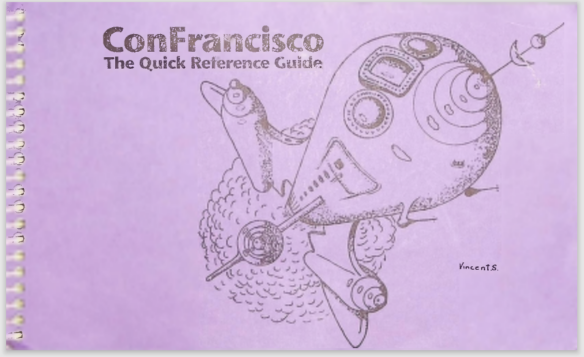
[Mike Glyer] The Incredible Shrinking Name: On the other hand, the badges are an example of what to avoid. Though David Bratman didn’t write it as a criticism, I think his description of people trying to read the badges at the GEnie party sums up the situation. “Never have I been to such a large party where so many of the attendees walked around hunched over, peering at each other’s nametags and periodically exclaiming, ‘Oh, so you’re so-and-so!”‘
Solutions to the Worldcon’s routine problems seem to get lost quicker than the secret of Damascus steel. Four years ago Noreascon pleased everyone by laser-printing headline-sized names on extra large badges. For some bizarre reason, the last two Worldcons continued the large badge size while printing the names in smaller, hard-to-read typefaces.
[Mike Glyer] The Bottom Line: The entrance hall used for registration was all glass and aluminum, reminiscent of the Crystal Cathedral. Access to the escalators involved a concealed sightline that surprised visitors at the last moment with a breathtaking, twenty-five foot descent into the exhibit hall. Or on Thursday morning, stunned them with the sudden realization that below was another huge line, snaking away from the program book distribution table.
Eric Watts heard that the reason Souvenir Books were distributed separately is that they weren’t ready when registration opened. However, another report said this arrangement for distributing program books was designed to reassure the publisher furnishing thousands of free copies of a new Niven/Barnes paperback that the books couldn’t pilfered by someone who’d tear off covers for returns. At the same time that fans picked up their program books they collected numerous other free books and souvenirs.
[Evelyn C. Leeper] Programming Statistics: There were 492 program items listed (not counting readings and autograph sessions). MagiCon had 420 program items, Chicon V had 520 program items, ConFiction 337, and Noreascon 3 833 (all not counting films or autograph sessions). I have no idea how many videos and films there were: due to family problems, the head of media programming had to withdraw shortly before the convention and the schedule was totally changed as the convention had to start from scratch at that point. (John L. Flynn came through with what must have been only hours notice with a series of lectures to go with the “Dracula” film festival that was shown one day.) There were also 33 autograph sessions and 29 readings. Once again, there were a lot of panels at this convention of interest to me, and I ended up with no time for lunch (and occasionally no time for dinner!)

[Evelyn C. Leeper] Panel: “State of the Short Story” (Thursday, 4:00 PM) [Panelists:] Maya Kathryn Bohnhoff, James Brunet, Scott Edelman, Rick Wilber. [Topic] “How does this form fare in science fiction and fantasy magazines and books, and in the rest of the literary world”.
Edelman began by saying that in his opinion, short fiction is where everything important happens first–it is the cutting edge. Other panelists felt that this might be connected to the fact that short fiction gives the author more immediate feedback or gratification. While a novel could take a year or more to write, a short story can be written in a much shorter length of time. So writers are willing to make the investment in experimenting in the shorter forms. In addition, there are more markets for short fiction now than there were ten years ago. This does not mean it’s easy to break into the market, but it is easier than before.
Because it is true that short fiction is not as profitable as novels, many people seem to feel that authors “graduate” from short fiction to novels. (See the introduction to Karen Joy Fowler’s collection Artificial Things for a description of this phenomenon: she says she prefers short fiction and even got a reputation as “the person who wouldn’t write a novel for Bantam.”) Wilber also thought that short stories were not only “a good place to get started, but … also a good place to be.” And Harlan Ellison, one of the most respected writers in the field, has never written a science fiction novel (though he has written a couple of non-science-fiction novels).
One problem with short fiction is that magazines have a definite shelf life. Stories may be popular, but after their month or two is up, they become impossible to find. While anthologies have a longer lifetime, they are less predictable or reliable. As Brunet put it, “The anthology is the hot date; the magazine is a long-term relationship.” It is true that inclusion in one of the “Year’s Best” anthologies will probably assure a story of being available for at least a couple of years, but original anthologies are trickier.
The panelists pointed out, however, that science fiction magazines at least have a readership. Literary magazines stay alive because of the pressures of academia: they provide a place to “publish” instead of “perish” for professors, and they are pretty much required reading for other professors. Science fiction magazines, on the other hand, stay alive because people want to read them. The opinion was expressed that this might even explain some of the hostility toward science fiction from academia: jealousy.
One recent phenomenon is the stand-alone novella from publishers such as Bantam. Priced below the cost of a novel and offering readers a chance to read a “book” without committing to a 600-page odyssey, they are also giving authors more market for novellas, traditionally a hard form to place.
Above all, though, Wilbur says, if you want to break into the short fiction market, “embrace rejection.” In agreement, Brunet said that the best experience he got for selling short fiction was his experience dating in his early twenties.
[Mike Glyer] Panel: Eric Drexler on Nanotechnology (Thursday 4:00 p.m.)
Nanotech prophet Eric Drexler spoke at ConFrancisco. Elton Elliot, that round mound of the profound, asked me if I’d heard nanotechnology might be applied to rid the body of excess fat. “I expect to see many people of the avoirdupois persuasion in the audience,” said Elton.
[Evelyn C. Leeper] Panel: “Today Is Tomorrow’s Yesterday” (Thursday, 6:00 PM) [Panelists:] Barbara Delaplace, John Hertz, Harry Turtledove (m) [Topic] “Likely errors in future historical fiction about our era”.
The panel started by defining “today” as the period from 1945 to the present. The most obvious errors, they said, would be simple anachronisms: pot-smoking free love in 1951 or a Beatles concert in 1947. Authors writing about a historical period need to throw in details like this to create verisimilitude–as Hertz said, “Verisimilitude is very tricky stuff”–but it is very easy to get it wrong. Suggesting a few details allows the reader to fill in the rest, and authors aren’t always careful about the details, especially if they think their audience is unfamiliar with the period.
Of course, unfamiliarity may not be the case. After all, there is a flood of information available for the present. Byzantine history (Turtledove’s specialty) requires inference from the documents surviving, but we are absolutely swimming in documents. Even with some of them unreadable due to obsolete media (such as music stored on eight-track tapes), there will be so much that it will be impossible to avoid verifiable errors with only a finite amount of research.
Another error is that people forget how quickly attitudes can change. This is what Mark calls the “Happy Days” Syndrome: the show took place in the 1950s, but everyone had the attitudes of the 1980s. This is also one reason that feminist Regency novels don’t work very well. (Hertz suggested that you think of a viewpoint as a geographic thing.) It’s easy to eat the food of people of another period and wear their clothing, but it’s hard to think their thoughts and feel their feelings. Turtledove warns, however, that you often have to tone down attitudes or the audience will be turned off by them. For example, the attitude that blacks were sub-human was very common in earlier centuries, yet having a “hero” who espoused this attitude, however accurately, would not be acceptable to modern audiences. Rest assured, though, that we will suffer the same fate or, as Turtledove put it, “Whatever you think about X will be considered absurd five hundred years from now,” where X could be religion, abortion, meat-eating, or any other subject. Yes, we think we have proof that our beliefs are right, but then previous generations also thought they had proof. Panelists also noted that some facts need to be left out–they are too convenient and people will think you have made them up.
One thing that Hertz felt characterizes our period as different that might very well seem absurd in the future is that we are as compulsively casual as previous cultures were formal. Whether the pendulum will swing completely back is not clear, but he feels that some return to formality will occur, and we will look absurd to future readers.
On the other hand, novels written about their own period can often skip important details that would be obvious to those of the author’s time, but completely lost on an audience a hundred years later. As one panelist said, he could tell when reading a Jane Austen that something important was going on, but he didn’t have the knowledge of the period to figure out what. Writers writing about earlier historical periods have to give the reader enough to understand what is happening. Georgette Heyer is supposedly good at this.
Turtledove observed that writing about the past was dangerous because “you have more excuse for making mistakes about the future than about the past.” Even so, some literary license is permitted since “historians deal with facts, novelists deal with truth.”
More basic questions raised were: Will anyone care about us? Why do we do the strange things we do? What are the future stereotypes of our age? These were not answered, but the last one brought about the observation that an era of history is only noticed after it is over. (As Kim Stanley Robinson noted in his lecture on Postmodernism people didn’t sit around in Europe and say, “Well, last year was the Dark Ages, but now is the Renaissance.”) Someone compared this to the cloud in Poul Anderson’s Brain Wave: you only realize it exists once you’re out of it.
[Mike Glyer] The Three Hundred Thirty-Nine Steps: Before the con, Kevin Standlee paced off the distance between facilities and published his findings: it is 968 “Standlees” from where I stayed in the Parc 55 Hotel to the door of the Moscone Convention Center, much of it along San Francisco’s Market Street; the daily run past throngs of homeless beggars, alcoholics and others scuffling to survive made a powerful impression on fans.
Two emotional responses were alloyed together, one of pity for the people’s desperate condition, the other of wariness for danger on the streets. In a four-block walk to the Moscone a person could see forty people camping inside doorways and construction scaffolding, be asked for money three or four times, and see several men sprawled on the sidewalk and know from their beet-red, dirty faces that they were passed-out drunk.
Eric Watts summed up the experience when he wrote, “The oddest feeling I had during ConFrancisco was when I was dining at the Parc’s Veranda restaurant with friends I hadn’t seen in several years, treating myself to what was, for me, a very expensive meal. We were seated next to the plate glass window, through which we all could see a homeless person lying under a blanket on the sidewalk against a building across the street. Another man walked past him, stopped and turned around, scouted the area briefly, bent over and took a box of food that apparently belonged to the vagrant, walked a few feet down the sidewalk and proceeded to eat whatever was inside. Everyone seated at my dinner table saw the incident, and we were all left speechless, silently outraged at the crime and silently disgusted at the sight of poverty, hunger and homelessness while we dined on fancy entrees with fine wine and cloth napkins. It was an uncomfortable and awkward moment.”
There was something to dislike about the neighborhood of the Moscone because of all the signs triggering a watchfulness for danger, whether or not danger was immediately present. I said so and some blamed me for anti-homeless bigotry. On the other hand I was aware of the following story.
When Robbie Cantor turned up on the first day of the con with three broken ribs, two black eyes and other bruises it wasn’t from a fall down a flight of stairs, as people were told at the time. Robbie, commenting that she violated her own rule, went unescorted at 1:30 a.m. from the Moscone to the ANA Hotel. She was accosted by a street person who hit her across the face with a plastic bag full of something, and they wound up in a street fight. In an exhausted standoff, they retreated toward the ANA. Robbie went inside and the assailant took off before police arrived. In the end, a police artist made a sketch of him from Robbie’s description for distribution to officers.
Robbie, part of ConFrancisco’s operations staff, reports that during the con members suffered three wallet or purse snatchings and another less severe mugging. Kurt Siegel pointed out that the number of crime incidents were lower than those he heard about at a computer-related symposium he attended in New York last February. But more fans were victims of crime, including violent crime, during this Worldcon than any other I know about, most of which never had any reports of street attacks and robberies.
Day-to-day encounters with street people profoundly influenced people’s experience of ConFrancisco, although some fans, like Eve Ackerman, managed to handle them cheerfully: “My favorite was the man selling newspapers produced by the homeless. He asked my husband to buy one as we walked to Union Square. ‘No thanks,’ Howard said and we kept walking. ‘How about one for your lovely daughter then,’ he yelled out. I did a 180, gave him a dollar and took a paper. I admire free enterprise.”
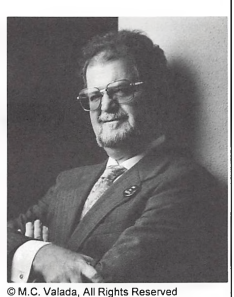
Larry Niven
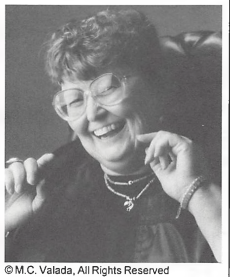
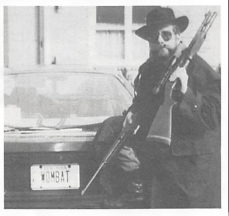

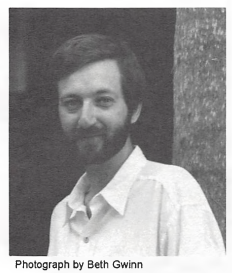
[Robert Sacks] Opening Ceremonies (from The Norton Reader #2) After a long wait on a line stretching three times around the Moscone South Lobby, the audience was allowed into the Esplanade Ballroom to wait.
At 8:52 the Opening Ceremonies finally began with a video and the song “I Left My Heart in San Francisco.” With ‘fog’ rising in the background, a model of the Golden Gate Bridge was rolled on stage and lit up. The crowd was easily pleased.
The audience was invited to give a big California welcome to the many worlds of fandom. After some musical numbers, the MagiCon Chair, Joe Siclari, was called upon to pass over the gavel, a golf club from MagiCon’s miniature golf course, to ConFrancisco chair Dave Clark; in addition he presented a chairman’s badge, estimated to have ribbons at least 6 feet long, in the Chair’s favorite colors, dalmatian.
Breaking ConFrancisco’s gavel, a loaf of sourdough bread, the Chair declared the convention off and running.
The several honored guests were interviewed on video. Toastmaster/Master of Ceremonies Guy Gavriel Kay introduced His Imperial Majesty Norton I, who entered and evicted Chairman Clark from the central chair of honor. The Toastmaster gave a brief history of the bid and convention, and announced the special guests from the Czech Republic. Larry Niven stated he was greatly honored and questioned why it took so long. Alicia Austin explained how she enjoyed people enjoying her artwork. Tom Digby, a suspected alien lifeform, blew soap bubbles. Wombat, jan howard finder, promoted backrubs. Mark Twain [‘channeled’ by Jon DeCles] talked about spending the coldest winter of his life one summer in San Francisco.
Senator Barbara Boxer’s letter of greeting was read; the President of the San Francisco Public Library Commission read Mayor Jordan’s proclamation of Sunday, the fifth of September, as World Science Fiction Day in San Francisco. H.I.M.’s reception was announced for Friday night. After the ConFrancisco anthem was sung to kazoo music provided by the LA Filkharmonic, Emperor Norton ordered the attendees to go forth and have a great time at ConFrancisco.
